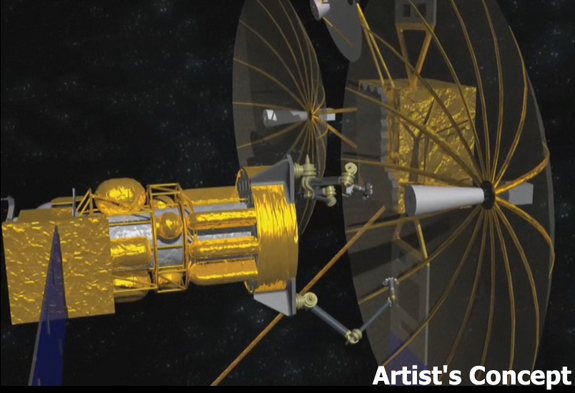

Our growing space junk problem could become an orbiting spare satellite parts sale if DARPA has its way. The DoD’s research arm has launched a new program, appropriately titled Phoenix, to create new satellites from the decommissioned and dead satellites currently sitting idle in geosynchronous orbit some 22,000 miles above the Earth.
Defunct satellites are in relative abundance in “graveyard orbits” where they have been placed to essentially stay out of the way of newer, working satellites. But while these satellites are out of fuel and out of power, they still retain functioning elements that are both useful and heavy–particularly their antennas. DARPA envisions a scheme where the inner guts of a satellite could be launched into space (at a relatively low cost, since the communications large antennas make up a decent portion of a satellite’s launch weight) and then be attached to an antenna already in orbit.
To do this, DARPA will need an orbiting space robot, or a “tender” spacecraft, that can make all of this happen on orbit. Like an automated mechanic, the tender would rendezvous with “satlets” (those are the small satellite “brains”) that would likely hitch rides on other satellite launches. It would then remove the satlets from the larger satellite or launch vehicle and carry the satlets to a dead satellite where it would attach the satlet to a used antenna and then cut the antenna loose from its former satellite. The tender would then place the new satlet-antenna combo in its new orbit. Just like that, the tender will have built a new satellite from old parts already available in space, limiting the amount of new debris introduced into orbit.
Of course, all of this is going to require some pretty big technological leaps, and as is often the case with DARPA, it’s the derivative technologies that could make the biggest impact here. DARPA is going to need, first and foremost, a space robot with keen machine vision and some degree of AI autonomy, the ability to refuel on orbit (possibly at the International Space Station, which is testing its own satellite refueling tech), and the ability to chase down and intercept satellites as they are orbiting (can’t think of a defense application there).
All said, if DARPA can pull this one off the agency is going to have a nice suite of orbital technologies at its disposal. Not that it would dream of using them for anything other than the originally stated purpose.